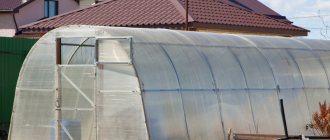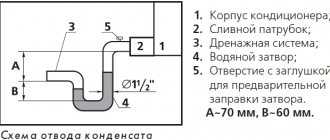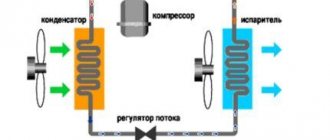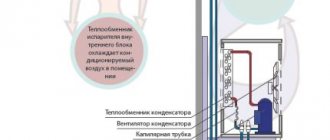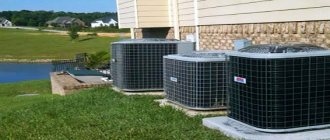In the summer heat, air conditioning becomes the best assistant, as it allows you not to suffer from the scorching rays of the sun, but to relax comfortably in your apartment. However, when the hot season ends, the device is no longer needed, so it is necessary to prepare it for the cold so that it does not become unusable over the winter, and can also work well next summer. Preservation of an air conditioner for the winter is carried out in several stages, and you can do it either yourself or use the help of specialists for this - there are many companies that service equipment and provide this service. However, the list of actions in both cases will be different.
Features of winter operation of a split system
As already mentioned, the minimum operating temperature of a split system during winter operation is indicated in the instructions for specific equipment:
- most non-inverter split systems are designed to operate down to -5 degrees, some models up to +5;
- most inverter units are designed for operation at -10 - -15 degrees;
- Some heat pump models from leading manufacturers are designed for heating at outside temperatures down to -28 and colder.
The efficiency of a split system is highly dependent on the outside temperature. At temperatures around zero, almost any air conditioner can produce several times more heat than the electricity used.
How to use air conditioning in winter
To determine at what temperature the air conditioner cannot be turned on in winter and when it can be used, you must carefully read the instructions for the specific model. The manufacturer clearly indicates everything there; going beyond the established temperature parameters is highly not recommended. The same applies to the heating mode. There is technology that can heat the air, and there is one that works exclusively for cooling.
Temperature distribution when the air conditioner operates in different modes
In winter, it is quite possible to use the air conditioner in all permitted operating modes, just like the same ventilation in the garage. However, you should make sure that its drainage does not freeze, and that the external block is secured to the wall taking into account the formation of an additional ice crust on it.
Possible breakdowns of split systems in winter
Every user should know that it is necessary to use a split system for heating according to the instructions; The main reasons for frequent breakdowns are improper use of the air conditioner and non-compliance with the temperature regime in winter. Situations often arise when, after pressing the necessary buttons and selecting the desired mode, the heat does not flow. There can be many reasons for this and they definitely need to be checked. The following phenomena are not uncommon:
- The batteries in the control panel do not work;
- the sensor does not respond well to the device;
- there are violations in the operation of software;
- severe damage to the air conditioner.
The most common cause of device failure is a malfunction of the batteries in the remote control, so many people think that they were given a defective device. Solving the problem is very simple, just change them for new ones and start the device again.
If the problem lies in a sensor malfunction, then in this case you will not be able to solve it yourself. It is best to return the device under warranty or call a repairman. If the air conditioner's warranty is still valid, then the air conditioner must be replaced with a new one or the sensor equipment must be replaced.
All this makes it clear that there are problems that urgently need to be solved before the device breaks down completely. Therefore, it is better not to try to repair the device yourself, but to contact a service center.
When the equipment completely stops working, if it was used for other purposes or was frequently rebooted, repairs for such problems will be expensive, and it is better to think about buying a new air conditioner.
Preventive measures
It should be taken into account that failure of the air conditioner due to improper technical maintenance or lack thereof will not be recognized as a warranty case. Therefore, repair or complete replacement of equipment will fall entirely on the shoulders of its owner. To avoid such unpleasant lessons, you should familiarize yourself with a few simple rules, the implementation of which will be the key to the efficient and uninterrupted operation of your equipment.
So, how should you turn on the air conditioner after a long period of inactivity? In fact, there are several simple rules, the implementation of which is mandatory for every owner of climate control equipment.
Temperature
The operating instructions for the device always indicate at what temperature the air conditioner can be turned on. As a rule, these indicators range from 0 to -5 ˚C. Thus, the device should not be turned on until the air warms up to the required temperature. In addition, at low temperatures there is no special need to turn on the air conditioner.
Cleaning the system
Cleaning the system
The air conditioner consists of indoor and outdoor units, each of which needs regular cleaning, and especially before starting.
Filters and internal parts should be cleaned at least once a month. And after a long winter period of inactivity, this procedure should be performed especially carefully: the indoor unit is washed with water, and to clean the external unit it is best to use a compressor with compressed air. If you ignore these recommendations, the equipment may fail. People who are in a room where an uncleaned appliance is operating will breathe dust and dirt that spreads inside the room when it is first turned on.
Before turning on the air conditioner, you should inspect the fan blades and grille to prevent leaves, poplar fluff, twigs and other foreign objects from getting into them. If you find that the grille needs cleaning, you can call a specialist or clean it yourself. To do this, the device must be disconnected from the power supply so that the moving fan blades do not injure your hands.
Electrical contacts
A mandatory step before starting is to check the electrical contacts and electronic components of the device. If malfunctions are found, it is best to call specialists who have special equipment to check the functionality of the compressor and other parts.
System pressure and refilling with freon
Checking the pressure in the system and topping up with freon is also necessary before starting the air conditioner. The main source that maintains its performance is freon. Freon leakage can lead to equipment failure. However, you should also remember about the so-called normalized leakage, which is considered an inevitable phenomenon caused by the peculiarities of the connection of the indoor and outdoor units. Freon is not dangerous for a person indoors, but if there is not enough of it in the air conditioning system, the device may work with significant interruptions.
Checking the exhaust air temperature
After checking the air conditioner and cleaning it, you should check what air is coming out of the vent. Normally it should be cold. To determine the degree of air coldness, subtract the temperature of the air entering the device from the temperature of the air leaving. This value is usually called temperature delta T. The normal value for it is a temperature from -11 to -6 C˚. If the temperature of the output air is below -11 C˚, the air conditioner will not be able to cool the air effectively enough in very hot weather. If the temperature is higher than -6 C˚, then the operation of the system may be disrupted.
Turn on the “AUTO” function: step-by-step instructions
Despite the fact that this function has a complex technical meaning and independently “selects” the necessary actions, its purpose is to facilitate the operation of the split system. It turns on very simply:
- We connect the equipment to the network, i.e. Insert the cord and plug into the outlet. A characteristic signal may sound and the device’s blinds should return to their initial position;
- Using the remote control, press the “ON/OFF” button;
- Then press the “Mode” button several times so that the word “Auto” or the automatic mode indicator lights up on the remote control (can be indicated as a triangle, in the form of various circular arrows or the letter “A”). Each press of the button “responds” with a sound signal.
- Some models suggest the ability to change the temperature for the specified mode. We change it using the “+”/“-” keys, respectively increasing or decreasing the required temperature.
Important!
Some air conditioner models can start immediately after plugging the plug into the socket. In this case, skip the second step (do not press the “ON/OFF” button). The fan speed is also displayed on the remote control of all air conditioners. This fan can have automatic speed. Those. “auto” may appear on the display, which refers specifically to the fan speed, and not to the “auto” mode
It is important to distinguish these two settings!
Consequences of operating the system at prohibited temperatures
If, when operating climate control equipment, you ignore the manufacturer’s recommendations on the maximum permissible temperature values, critical breakdowns are possible.
Why it is impossible to use systems that are not intended for operation in winter is additionally indicated by the manufacturer in the precautionary measures. Here's what happens if you don't follow the restrictions:
- reduction in the efficiency of equipment up to shutdown;
- icing of the external and internal units;
- thickening of oil in the refrigerant;
- excessive friction of parts without lubrication;
- the appearance of ice in the drainage tube;
- leakage of condensate into the living space;
- broken fan blades;
- Compressor wear and breakdown.
Ventilation of the room with air conditioning
There is one more important thing to consider. The air conditioner does not interact with the air outside in any way. It circulates the same air around the room, and the external installation is only responsible for removing excess heat from the room.
Only refrigerant moves between the indoor and outdoor units of the air conditioner, usually freon. It removes excess heat from the room, but does not renew the air
Air exchange is also important to maintain comfortable indoor conditions. And if you do not ventilate the room for a long time, the oxygen level will decrease and the level of carbon dioxide will increase. Of course, this is not fatal, but the lack of oxygen can make you feel tired and drowsy.
Before ventilating the room, be sure to turn off the air conditioner. Open windows and, if possible, doors. This creates a draft, but allows the air to renew itself very quickly. It is advisable that at this moment there is no one in the room, especially children. If there is no way to vacate the room, then it is better to limit yourself to windows only.
We said above that when the air conditioner is on, it is necessary to close the windows, and when ventilating, turn off the air conditioner. Let's figure out why this needs to be done.
Modern air conditioners do not blow at the set power all the time. They cool the room to a set temperature, after which they begin to work to maintain it. This allows you to wear out the equipment and filters less quickly and save energy.
If you open the windows when the air conditioner is on, active air exchange will begin to occur in the room. Hot air from the street will replace the cooled air in the room. In this case, the air conditioner will work at full capacity, actually cooling the street.
Powerful models may be able to maintain the set temperature even with the windows open, but this will lead to rapid wear and tear.
If you forget about it once, then nothing bad will happen. However, repeating this on a regular basis, there is a high chance of being left without air conditioning and with a huge electricity bill.
We also recommend reading our other article, where we described in detail the principle of operation of the air conditioner.
Important information about temperature limits
For the cold season there are important restrictions. You cannot turn on the heating when the outside temperature is below 0 C°, otherwise the following problems will begin:
- the condensate on the external heat exchanger begins to freeze, so the outdoor unit begins to become covered with ice;
- as a result, heat transfer deteriorates;
- heating performance decreases.
At what temperature exactly can you turn on the air conditioner for cooling? It is important to ensure that it does not fall below +5 C°. If it is violated, the following may happen:
- the performance of climate control equipment will decrease;
- freezing will occur in the structure of the street block and drainage pipe;
- The compressor may break down during startup.
Air conditioner operating diagram
Let's sum it up
In this publication, we examined the question at what temperature you can turn on the air conditioner for heating in winter. Let's summarize the above:
- Check the minimum operating temperature in the instructions for your model;
- The average minimum temperature of inverter air conditioners is: -30...-20 °C, conventional: -5...+5 °C;
- The compressor of a conventional air conditioner wears out faster in cold weather than that of an inverter;
- It is better to start the air conditioner at a temperature higher than the minimum by 2-5 degrees;
- The colder it is “outside”, the worse the air conditioner heats;
- Warm up the air conditioning compressor for 2-3 minutes with minimal load;
- If you don’t want problems, install a winter kit.
Sources
- https://vozduhstroy.ru/kondicionery/pri-kakoj-temperature-mozhno-vklyuchat-na-obogrev.html
- https://hitech-online.ru/klimaticheskaya/konditsioner/pri-kakoj-temperature-mojno-vklyuchat.html
- https://domikelectrica.ru/otoplenie-doma-kondicionerom/
- https://TopVentilyaciya.ru/konditsionirovanie/mozhno-li-vklyuchat-konditsioner-zimoj.html
- https://morrozko.ru/ispolzovanie-konditsionera-zimoy-na-obogrev/
- https://dantex.ru/articles/mozhno-li-vklyuchat-konditsioner-zimoy-obogrev-i-okhlazhdenie-pri-nizkikh-temperaturakh/
- https://tehnika.expert/klimaticheskaya/kondicioner/pri-kakoj-temperature-mozhno-vklyuchat.html
- https://sovet-ingenera.com/vent/cond/mozhno-li-ispolzovat-konditsioner-dlya-obogreva-pri-moroze.html
- https://StrojDvor.ru/kondicionirovanie/mozhno-li-ustanavlivat-i-ispolzovat-kondicionery-zimoj/
- https://tehnofaq.ru/rabota-konditsionera-zimoj/
- https://VTeple.xyz/pri-kakoj-temperature-mozhno-vkljuchat-kondicioner-na-obogrev/
Why is it important to observe the temperature difference?
Modern climate control equipment works wonders. Outside the window it may be incredibly hot at 40 degrees, but indoors the air conditioner can maintain a comfortable coolness of 20 degrees.
But it is worth considering that sudden temperature changes of more than 7 degrees can cause ARVI with further exacerbations, even pneumonia. If you walk from a hot street into a cool room with air conditioning, you will feel comfortable. However, the risk of getting sick will increase several times.
If you stay indoors all day, maintaining the temperature difference can be neglected. But being under a cold stream all the time is not recommended.
Therefore, it is necessary to set the temperature of the air conditioner in rooms where people often enter and exit, taking into account the above difference.
If we are talking about office space, then failure to comply with this simple rule can lead to all employees going on sick leave.
Extending the life of the device
In addition to the above, operating the air conditioner in frosty weather will not only remove excess water vapor from the interior, but will also extend the service life of the device. Of course, you don’t need to run it every day to do this: it will be enough to turn on the device about once every 7-10 days, leaving it running for at least 15-20 minutes.
The thing is that the film of oil covering the surface of the internal parts of the device slowly flows down, remaining only in some places of the air conditioning system.
The more time this vehicle unit is inactive, the longer its compressor, after starting, will operate on dry friction, until the lubricant is distributed throughout the entire system.
A compressor is a fairly expensive piece of equipment, so its breakdown due to prolonged downtime will cause serious damage to the budget. But even replacing it will not bring the expected result.
All metal particles from the surface of the parts, which will be “ripped off” from them as a result of the compressor operating in dry friction mode, will be dispersed throughout the entire system.
Even if it is washed before installing a new unit, it will not help much: metal particles will certainly remain and end up in the new compressor, where they will worsen its condition.
Therefore, in winter, turning on the air conditioner is not only possible, but even necessary in order to extend its service life.
Split system temperature sensors
temperature sensor in the indoor unit
It was already mentioned above that air conditioners are equipped with special temperature sensors that monitor both street and room indicators, as well as values inside the device itself.
Modern split systems have a developed self-diagnosis system, the elements of which are temperature sensors. The main ones among them are two sensors: air temperature sensors and indoor unit evaporator sensors. They determine the operating algorithm depending on the selected mode. Air conditioners are equipped with these temperature sensors in the simplest configuration.
More expensive systems are equipped with the following types of temperature sensors:
- outside air temperature sensor – does not allow the air conditioner to turn on at sub-zero and plus temperatures, which are below/above the permissible norm;
- condenser temperature sensor (there may be several of them) – is responsible for maintaining the required level of condensation pressure for a given mode when street conditions change;
- room air temperature sensor – responsible for maintaining the functionality of the compressor;
- Evaporator temperature sensor – turns off the compressor if the temperature of the air conditioner evaporator drops to zero.
Temperature sensor in the remote control
Some split systems have an additional function - automatic defrosting of the heat exchanger of the external unit. This is necessary to prevent icing processes that cause the fan blades to break. The defrosting mode of the air conditioner is activated at sub-zero outside temperatures. Thermal sensors are also responsible for this.
Another function of modern split systems is the automatic selection of a mode, which, when started, sets a “comfortable” temperature at +20°C. Sensors are also responsible for the proper operation of automatic installation of standard indicators.
If we talk about the temperature of the air conditioner evaporator, then there is a direct dependence on external factors - the higher the thermometer readings outside the room, the more intensely the evaporator heats up.
For all-season splits, when the compressor is turned on, the difference between the temperatures of the air and the air conditioner evaporator should be at least 5-7°C. When the compressor is turned off, these indicators change towards lower values. When a decrease does not occur, this indicates a system malfunction.
Evaporator temperature sensor
When operating the device for heating, the air parameters in the room are also taken into account. If the air conditioner temperature sensor responsible for room data shows a difference between the outside and indoor temperatures of less than 5°C, the compressor may automatically shut off or it may not start initially.
When the air conditioner is operating for cooling, the temperature at the outlet of the indoor unit should be at least 10°C below the thermometer outside. It is worth remembering that when starting a split system, these values may not be reached immediately, so cooling occurs less intensively.
The longer the air conditioner is on, the more optimally it cools.
Coming out as a replacement.
The issue of replacing outdated or failed models with new ones deserves special attention. Split systems, as you know, consist of two blocks (internal and external), connected by copper tubes through which the refrigerant circulates, as well as interblock communication wires. The technical parameters of all elements of this system (number of wires, diameter and design of pipes) may vary depending on the brand, performance and features of each specific model. Therefore, it is possible to install new blocks on pipes already laid in the walls only when all the parameters of the old and new models coincide - and choosing such a replacement is not so easy. As a result, in most cases it is necessary to completely change the entire system and lay new pipes. Things may be somewhat simpler if the new model is of the same brand as the old one; they may have many of the same parameters. Some manufacturers even specifically provide for easy replacement of their equipment with updated versions.
In recent years, the market has seen a massive replacement of split system models operating on R22 refrigerant with new models using R41QA refrigerant. This happened due to stricter requirements for the environmental safety of freon mixtures. Therefore, owners of air conditioners charged with R22 freon (such models were very popular on the Russian market due to the combination of low cost and good performance) may encounter problems when replacing a worn-out device. New equipment operating on R410A freon cannot be installed on tubes from a model using R22. Rare exceptions are split systems with R410A refrigerant with a specially built-in possibility of installation on pipes from R22 without previous flushing of the lines.
For reference: Most modern split systems can not only cool the air, but also heat it. This is possible thanks to the “heat pump” function: the device swaps the functions of the heat exchangers, as a result, the indoor unit begins to release heat into the air, and the outdoor unit – cold.
Under good conditions (not very low temperatures outside), air conditioners heat the room even more efficiently than, for example, electric heating devices. After all, the latter are not capable of producing more than 1 kW of heat per 1 kW of consumed electricity, while a split system will cope with this task. It spends electricity not on heating the air, but on transferring heat from one environment (outdoor air) to another (indoor air) through the operation of a compressor and fans.
But still, air conditioners will not be able to completely replace heating devices - when the off-season turns into winter, the heating performance of the device will begin to gradually decrease. After all, the lower the outside air temperature, the lower the efficiency of the split system. And in very severe frosts, the devices will not be able to work for heating at all. Therefore, a decrease in the thermal power of appliances when the outside air temperature drops is a natural phenomenon, and not a consequence of a malfunction of the split system. A significant part of the air conditioners that are supplied to the Russian market are capable of heating the air at temperatures of about 5-15 °C below zero, although some models are specially equipped with what is also called a winter kit - they are more “frost-resistant” and operate even at 20-30 °C To prevent the condenser of the outdoor unit from freezing when operating for heating in cold weather, many companies provide the possibility of automatically defrosting the heat exchanger.
Preparing your air conditioner for winter
In many climate control companies, closer to the cold season, there are many requests for preparing the air conditioner for winter. What is it and can you make it yourself?
Insulating the air conditioner for the winter
What is insulating an air conditioner for the winter and how is it done? The outdoor unit can be wrapped in thick cellophane film, the indoor unit is either also covered with polyethylene, or the hole from the drainage drain is plugged.
There is no other way to insulate the air conditioner for the winter if we are talking about a split system. As already mentioned, for a mobile unit you simply close the plug on the street side, and for a window unit, it is advisable to cover the part of the device protruding outward with a film or warm material. Sometimes window monoblocks have to be dismantled for the autumn-winter period, since they can serve as conductors for cold air to enter the apartment.
Self-preparing your air conditioner for winter
It turns out that you can prepare your home air conditioner for winter yourself, but how to do it correctly?
- First, turn on the split system for a couple of hours in fan mode, and then for an hour in heating mode. This will help thoroughly dry all the internal components of the device;
- Wipe off dust from the outer surfaces of the device with a soft, slightly damp cloth. Professionals usually use microfiber for this;
- Wash the mechanical filters in the indoor unit;
- Completely de-energize the system;
- Remove the batteries from the remote control.
There is no need to take any further additional actions on how to prepare your air conditioner for winter. The only thing is that those who have a split system on the windy side may want to think about insulating the refrigeration machine.
Professional preservation of air conditioner for winter
Professional services for preparing (preserving) an air conditioner for winter usually include the following list of works:
- pumping freon into the outdoor unit;
- complete de-energization of the system to avoid accidental switching on;
- installation of protection for the external unit from falling icicles in the form of a special iron visor;
- cleaning the indoor unit.
Although the entire list of listed services is not always required. It is better to carry out a thorough cleaning of the indoor module with washing of the filters, heat exchanger and fan before the start of the warm season, and before the cold weather it is enough to rinse the mechanical cleaning filters in a soapy solution. Freon pumping can be eliminated altogether. As practice shows, it survives well until spring without unnecessary manipulation. Professional preparation of the air conditioner for winter or its preservation is justified in the case of commercial or industrial equipment. In this case, service departments may refuse warranty repairs if the device was not sealed before the cold weather. In order to reactivate the equipment, you will have to contact the climate control company again.
Beware of icicles"!
Surely many of you remember the abnormally snowy winters that came to St. Petersburg and Moscow, when public utilities could not cope with cleaning the roofs of snow and the notorious “icicles,” the fall of which damaged dozens of cars and hundreds of outdoor air conditioning units until they were damaged beyond repair. And if it is still possible to obtain an insurance payment for a car, then damage to the air conditioner, alas, in most cases is the sole concern of its owner. Home-made devices designed to protect the external unit from the violence of the elements do not always properly perform their function, and if they are not secured correctly, they are simply dangerous for those passing near the house, especially during strong gusts of wind - alas, this is not a theory, but cases from practices. Professional preparation of an air conditioner for winter necessarily includes installing a new one or checking the quality of fastening of an existing protective canopy made of light and durable material, which will protect the external unit from the formation of ice and snow caps, gusts of wind, mechanical damage when snow melts or icicles fall from the roof .Winter is ahead, but spring is just around the corner! Prepare your air conditioners for it in the fall, and our company’s specialists will be happy to help you with this!
Summer work
Any air conditioner with a cooling mode does not have a heating element. There is a valve inside the outdoor unit that helps the refrigerant circulate. The evaporator and condensate change places, and the heat exchanger of the indoor module receives the heat of the freon and cools it. The propeller forces air through the condenser and heats the air flow. The freon arrives to the outdoor unit already cold. There it takes heat from the room and releases cold.
The air conditioner does not heat the air inside, but simply circulates it. This plan is effective when the temperature outside is above zero. If the outside temperature is below 0°C, the air conditioner may not cope with the task, so it is better to purchase a more powerful model. It will warm the room even in severe frosts.
This is how an air conditioner works
Cold air entering the room
If there is blowing through the hole under the air conditioner when it is turned off, you should cover the surface of the indoor module with plastic film. In some cases, changing the position of the drainage tube helps. She is turned the other way. It is through this that cold air enters the room.
If the blowing from the street is very strong and the above methods are ineffective, use another method. There is a hole on the surface of the indoor unit through which condensate drains. You need to find it and plug it with a rag. To do this, remove the outer facing panel and unscrew the screws that secure the drainage pan. It is usually located under the heat exchanger.
If gurgling sounds occur when the air conditioning system is started or turned off, do not immediately panic. After some time they should disappear. If the problem persists, you should check the drain tube. Condensation can accumulate and freeze in it. Also, a similar situation sometimes arises as a result of poor-quality installation of the pipeline through which freon is delivered.
Nuances of operation
Modern models of air conditioners are quite complex household appliances, the setup of which requires compliance with basic rules.
- It is necessary to clearly select the power of the product depending on the volume of the room: in regions with very hot climates it is necessary to install systems with higher power, with improved cooling characteristics.
- Always correlate the operating mode of the product with the weather conditions outside.
- In order to prevent the occurrence of any colds, it is necessary to fine-tune the equipment in cold mode.
- Carry out regular maintenance - these measures will allow you to ensure normal operation of the product and a safe and comfortable microclimate for the whole family.
- Installation, maintenance and repair of equipment should only be done by professionals.
Climate systems can be installed in any premises, regardless of their configuration and dimensions, because modern technology copes with the task without any problems. The user must only follow all the rules and recommendations stated in this article.
Preparing the device for winter
In order to prepare the split system or device for winter, it is necessary to pump the refrigerant into the external unit. Next, you will need to completely turn off the system so that it is not activated unintentionally. Next, special protective canopies are installed over the street block to prevent icicles from sticking and damaging the device. The internal mechanism is also cleaned.
You can prepare the device yourself as follows. First you need to activate the device for 2 hours to cool down. Then you need to work in heating mode. This makes it possible to completely dry all the internal elements of the equipment. Next you need to wipe off the dust from above. The filter must be washed and dirt and dust removed. The system must be completely unplugged and the batteries removed from the remote control so as not to be turned on accidentally.
If your system is located on the windy side, then you should try to insulate the block additionally. Many people simply wrap it in cellophane on the outside. Inside, they simply cover it with something.
If you don’t need air conditioning in winter, then you don’t need any additional care for it. Simply clean it, close it and turn off the power. Insulate if necessary.
If a split system can be used in winter, then it is necessary to wash the filters, fan and other elements where dirt and dust could accumulate. The regularity of such procedures may depend on the dustiness of the room itself. The number of people who are constantly in the room, as well as the number of furniture, carpets and other things, also affects. If there is not a lot of dust, then one procedure per season is enough.
Variable speed drive
The regulator is installed according to the electrical diagram of the external module and the moderator connection diagram.
When reading the controller diagram, pay attention to the difference in connecting single-speed and multi-speed fans.
According to the diagram (Fig. 1) we connect:
- yellow input cable of the regulator to the corresponding fan terminal;
- We connect the standard orange wire to the black output of the regulator.
With a multi-speed fan (Fig. 2):
- All fan speeds are set to the yellow input cable of the sensor;
- black is connected to the maximum speed.
If there is a heating mode, we connect its wire to the terminal according to the diagram; if not, we insulate it and attach it to the body. We attach the remaining wires (blue, brown), heating wires to the clamps, and supply power to them.
Possible breakdowns
Every user should know that it is necessary to use a split system for heating according to the instructions. The main reasons for frequent breakdowns are improper use of the device and non-compliance with temperature conditions. Situations often arise when, after pressing the necessary buttons and selecting the desired mode, the heat does not flow. There can be many reasons for this and they definitely need to be checked. The following phenomena are not uncommon:
- The batteries in the control panel do not work;
- the sensor does not respond well to the device;
- there are violations in the operation of software;
- severe damage to the air conditioner.
The most common cause of device failure is a malfunction of the batteries in the remote control, so many people think that they were given a defective device. Solving the problem is very simple, just change them for new ones and start the device again.
If the problem lies in a sensor malfunction, then in this case you will not be able to solve it yourself. It is best to return the device under warranty or call a repairman. If the air conditioner's warranty is still valid, then the air conditioner must be replaced with a new one or the sensor equipment must be replaced.
All this makes it clear that there are problems that urgently need to be solved before the device breaks down completely. Therefore, it is better not to try to repair the device yourself, but to contact a service center.
When the equipment completely stops working, if it was used for other purposes or was frequently rebooted, repairs for such problems will be expensive, and it is better to think about buying a new air conditioner.
What is the air conditioner temperature in summer?
In most cases, when the weather is hot outside, the room temperature should be 24-25 degrees. But if the outside temperature is 35 degrees, then first it is better to set the temperature to 30 degrees, and after 20 minutes you can reduce it to the desired one.
For offices, classrooms and other premises where work is performed primarily in a sitting position, the air temperature in the warm season should be 23-25 C, but fluctuations within 18-28 C are allowed.
There are times when a person cannot set the temperature in the air conditioner himself; in this case, you need to linger a little in the hall or dressing room; in these rooms there is not such a sharp temperature difference. Only after being there for about 3-5 minutes can you enter a cooler room.
If the temperature difference is more than 5 degrees, there is a risk of a sharp redistribution of blood in the body, and this can be a serious blow for people who have problems with the cardiovascular system. Moreover, this applies not only when a person goes from hot to cold, but also vice versa, from cold to warm.
The optimal air temperature in gyms and other sports facilities located indoors is 17-19 degrees C +/- 2 degrees in winter and 18-28 C in summer. For sports such as hockey or curling, the room temperature is much lower.
In what cases is it prohibited and not recommended to turn on the car air conditioner in winter?
There are many benefits from periodically turning on the AK in the winter, but there are also a number of contraindications for this operation, in which turning on the device would be extremely undesirable. Let's consider all such cases:
- If the outside thermometer drops below 5 degrees below zero and the car is parked outside, you cannot turn on the air conditioning. You need to wait for warmer weather, and if deadlines are running out and the frosts continue, look for a heated room (garage, service station, parking lot in a shopping center, etc.);
- when the cooling system has frozen (this happens if the characteristics of the coolant poured into the system do not correspond to the weather). Ice and sediment can cause irreparable damage to the system;
- if a refrigerant leak is detected due to depressurization of the line or for other reasons;
- You cannot turn on the AK even if there are minor faults, especially after a long period of inactivity. In such cases, it is necessary to inspect the air conditioning system and eliminate problems;
- In winter, it is strictly not recommended to immediately use the blower and maximum power mode when turning on the car air conditioner. This combination is a real stress for the system. However, such experiments will not improve the health of the driver and passengers either;
- If you notice an unpleasant odor after turning on the air conditioner, it’s time to clean the device from fungus, bacteria and mold. This operation is called flushing; it is better to entrust this work to professionals. Manufacturers recommend performing it approximately once every five years, but in reality it is performed more often, especially on older cars.
Although there is no need to cool the air in the cabin in winter, the air conditioner cannot be called a useless device in the cold season. Its periodic inclusion is highly desirable for preventive purposes. By doing this, you will prevent early wear of the car air conditioner parts and extend its service life. And since in winter there is usually high humidity in the car, drying the air is the key to the health of drivers and passengers, as well as protecting body parts from corrosion.
Main problems
If you accidentally or intentionally turn on a regular air conditioner in severe frost, this can lead to big problems. The complexity of the breakdown depends on the mode of use and on what temperature was outside at the time of switching on. If you turn on the device for heating the apartment when it is -5 ° C outside, the outdoor unit will begin to become covered with ice, as it will release condensation. Heat transfer will deteriorate and heat output will decrease. Refrigerant may enter the compressor and damage the unit.
The compressor's performance will drop, leading to serious damage.
Cleaning the air conditioner
The instructions for the air conditioner provide for proper care. Especially if the device is active and works regularly. The split system must be cleaned periodically to maintain vacuum.
It is recommended to clean filters twice a month
Cleaning the indoor unit.
- Remove the cover and remove the filters. Wash them in warm water with a non-aggressive detergent.
- Carefully remove the rotor fan and wipe the blades with a damp cloth.
- Carefully clean the heat exchanger using a vacuum cleaner. For hard-to-reach places, use a thin brush.
- After the components have completely dried, install them in place.
If there is rust on the body, you need to call a specialist. Possible freon leak.
Cleaning the outdoor unit
- Remove branches, leaves and large debris from the grille and fan blades.
- Remove the cover. Clean surfaces with a cloth or vacuum cleaner. Be careful not to let water come into contact with electrical parts.
- Wash the radiator plates using high water pressure: shower, hose, car washer.
- Reinstall all parts.
The external unit does not need to be cleaned as often as the internal one
However, it is important to remove large debris in a timely manner so that the device does not overheat
Care
No special care of the air conditioner is required in winter if you do not plan to use it throughout the frosty period. It is enough to carry out preparatory work on cleaning and de-energizing, and in the spring call a specialist to carry out comprehensive maintenance.
If you use an air conditioner in winter, you need to take care of it from time to time - clean the external panels and mechanical filters of the indoor unit, and also, if necessary, wash the fan and heat exchanger radiator in the room module.
The frequency of treatment depends on the dustiness of the room and the number of people constantly present there. If you have carpets, rugs, curtains and other fabric surfaces, cleaning will have to be done at least once a month. If the room is slightly dusty, it is not necessary to maintain the air conditioner so often in winter. Cleaning once a season is sufficient.
The most basic point of high-quality air conditioner care is still compliance with the established framework, even for systems with an extended operating temperature range. It is also worth remembering that when turning on the device in cold or warm conditions, you should not keep the window and balcony door open.
How many degrees can the air conditioner be turned on?
Typically, the air conditioner operates in heating mode when the air temperature exceeds -5 degrees. If there are lower temperatures, then the heating system cannot be used due to the process of reducing the power of the system, breakdown of the drainage and the risk of condenser icing and subsequent repair of the inverter.
In general, it can be stated that turning on the air conditioner in winter should be done with caution in order to heat up, following the operating instructions. It is better not to use the system if the thermometer shows a critical point, which is declared by the manufacturer
Cooling
Nowadays, it is not uncommon for a situation to arise when winter air conditioning sets are required to remove heat inside even at extremely low temperatures outside the window. Very often, there is simply expensive heating equipment in the room, which quickly warms up the entire surrounding space. You end up with a surplus that needs to be disposed of quickly.
This is especially important in work areas such as server rooms
Naturally, users have a question: which air conditioners can be turned on in cooling mode? Most devices are simply not ready to work for cooling in winter. Usually, if the temperature is below 5 degrees Celsius, the heating automatically turns on.
There is a special kit for winter that increases and decreases the speed of all ventilation systems. There is even a complete set even from leading manufacturers that heats the drain hose, crankcase and pressure regulator. In general, these guys have everything thought out in detail, so you can’t tamper with it.
